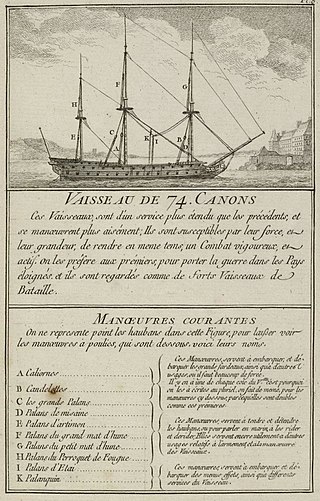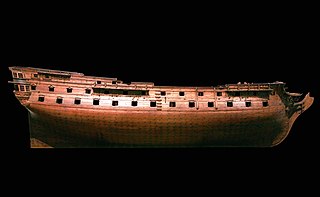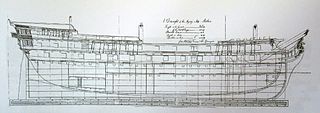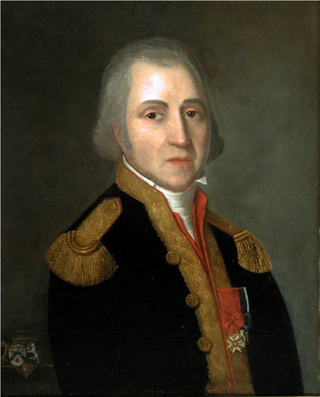
The Redoutable was a Téméraire-class 74-gun ship of the line of the French Navy. She took part in the battles of the French Revolutionary Wars in the Brest squadron, served in the Caribbean in 1803, and duelled with HMS Victory during the Battle of Trafalgar, killing Vice Admiral Horatio Nelson during the action. She sank in the storm that followed the battle.

Artésien ('Artesian') was a 64-gun ship of the line of the French Navy, lead ship of her class. She was funded by a don des vaisseaux donation from the Estates of Artois.
Solitaire was a 64-gun ship of the line of the French Navy, built by Antoine Groignard and launched in 1774, lead ship of her class. She was captured by the Royal Navy on 6 December 1782, and commissioned as the third rate HMS Solitaire. She was sold out of the Navy in 1790.

Diadème was the lead ship of the Diadème-class 74-gun ship of the line of the French Navy.

The Vengeur was a 64-gun ship of the line of the French Navy designed by Antoine Groignard. She saw action with Bailli de Suffren during the American War of Independence.
Pandour was a French a 14-gun gun-brig launched in 1780 as a cutter. The Royal Navy captured her in December 1795 and took her into service as Pandora, but she foundered in June 1797.
Amand Leduc was a French sailor and Navy officer of the First French Empire.
The action of 7 June 1780 took place during the American War of Independence between the frigates Hermione and HMS Iris. The ships exchanged fire for one hour and a half before parting. The battle resumed in written form when James Hawker published his account of the battle in a newspaper, which Louis-René Levassor de Latouche Tréville contested heatedly.
Théobald-René, Comte de Kergariou-Locmaria was a French Navy officer and Royalist émigré.

Robuste was an 74-gun ship of the line of the French Navy, built by Antoine Groignard.
Laurent-Emmanuel de Renaud d'Aleins was a French Navy officer. He served in the War of American Independence.
Charles Louis de Bernard de Marigny was a French Navy officer. He served in the War of American Independence.

Pierre de Roquefeuil-Montpeyroux was a French Navy officer. He served during the War of American Independence.

Roland was an Artésien-class 64-gun ship of the line of the French Navy, launched in 1771.

Étienne Marc Antoine Joseph de Grasse-Limermont was a French Navy officer. He took part in the War of American Independence, earning a membership in the Society of Cincinnati. A Royalist, he betrayed France and was an aid to Trogoff when he surrendered Toulon and its fleet to the British. He remained employed by the British until 1814.
Victurnien-Henri-Elzéar de Rochechouart de Mortemart was a French Navy officer. He served in the War of American Independence, and became a member of the Society of the Cincinnati.
Aigrette was a Blonde-class 30-gun frigate of the French Navy. She took part in the Seven Year War and in the War of American Independence.
Diligente was a 26-gun frigate of the French Navy. Originally built for the French East India Company, she was purchased by the Navy and took part in the War of American Independence.
HMS Alert was an 18-gun cutter of the Royal Navy. She took part in the War of American Independence, where she was captured by the French Navy and brought into their service. She was part on the squadron under Grasse until a British frigate recaptured her.
The Second voyage of Kerguelen was an expedition of the French Navy to the southern Indian Ocean conducted by the 64-gun ship of the line Roland, the 32-gun frigate Oiseau, and the corvette Dauphine, under Captain Kerguelen. The aims of the expedition were to confirm the findings of the First voyage of Kerguelen, returning the Kerguelen Islands and exploring what was thought to be a peninsula of a southern continent.








